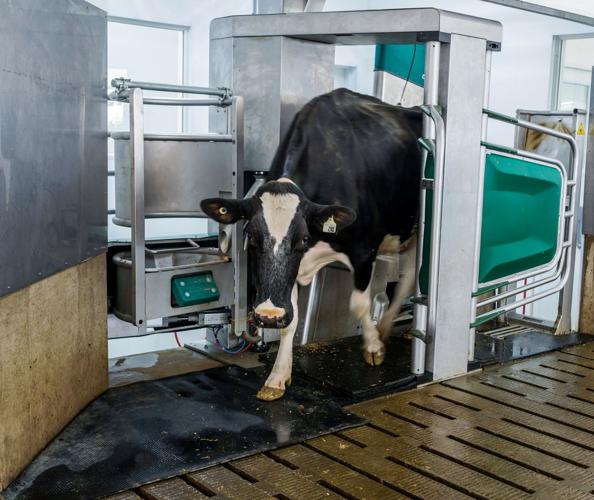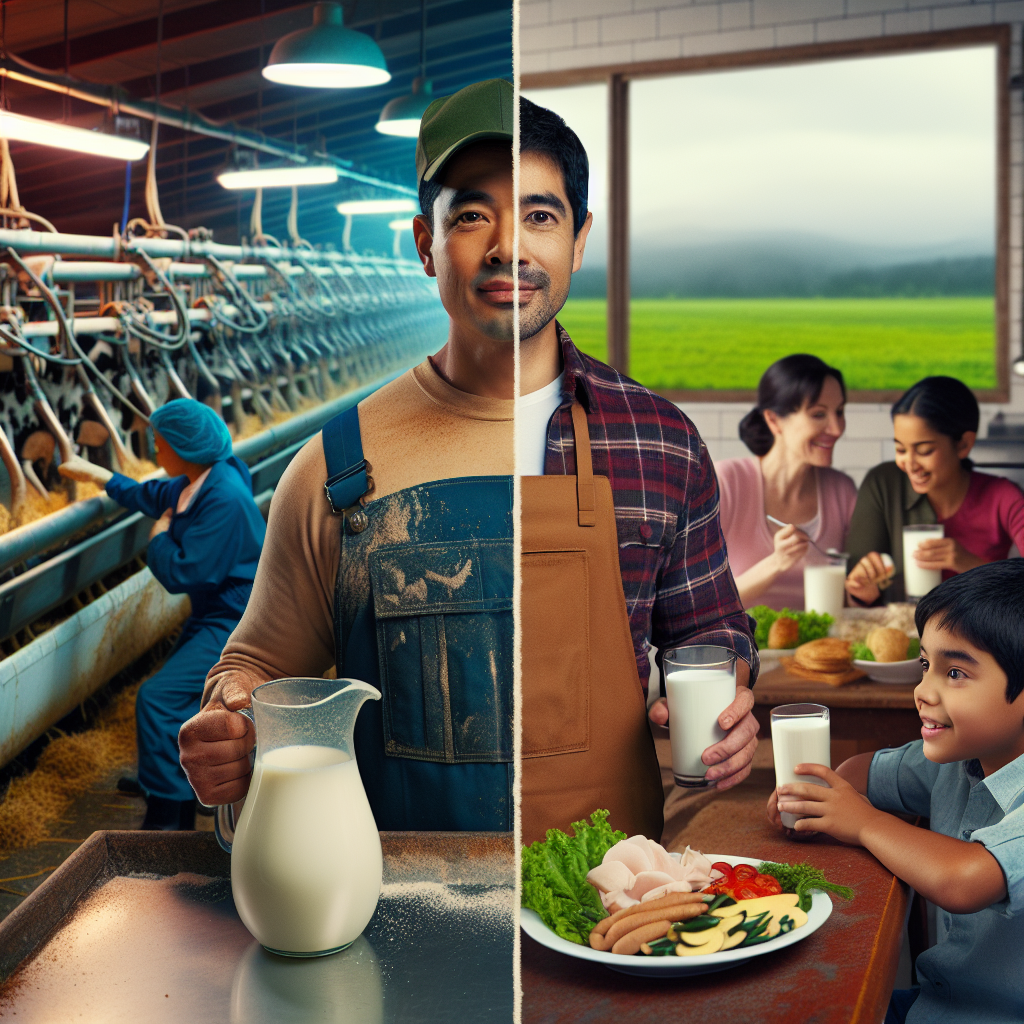Ready to make your dairy farm more efficient and give your cows a better life? Learn how robotic milking can cut down labor and streamline your workflow.

Efficiency is vital for successful dairy production in today’s rapidly changing agricultural world. Technological advancements significantly advance production, animal welfare, and farm management. Robotic milking devices are leading the drive to alter conventional dairy procedures. These devices make milking more efficient, minimize labor needs, and provide farm families with a more flexible lifestyle. This article examines the advantages and disadvantages of robotic milking, emphasizing its influence on daily routines and farm architecture. Join us as we look at how these sophisticated technologies improve efficiency, sustainability, and profitability in dairy farming, resulting in a substantial change in farm management techniques.
Robotic Milking Technology: A Revolutionary Advancement in Dairy Farming
Robotic milking technology is a significant advancement in dairy production. Automating the milking process improves both worker efficiency and animal welfare. The system comprises automated milking machines, heat-sensing equipment, and data management software. Cows enter the station freely, accompanied by electronic tags. A robotic arm carefully cleans and connects milking cups, analyzes milk flow, and assures maximum extraction. The system then prepares for the next cow by cleaning the equipment.
Advancements have increased the efficiency and accessibility of this technology. Modern milking systems utilize machine learning to tailor the process, enhancing comfort and production. Improved sensors and data analytics enable farmers to monitor their herds better, promoting proactive health and productivity management. These solutions reduce manual labor, increase milk output, and improve farm management.
Transforming the Dairy Industry: The Multifaceted Benefits of Robotic Milking Systems
Robotic milking systems are transforming dairy farming by significantly decreasing manpower needs, allowing farms of all sizes to function effectively. This technology enables dairy farm families to manage their time better and avoid the tight timetables of conventional milking.
Robotic milking not only saves labor but also improves cow well-being. Since cows pick when they are milked, they enjoy a more peaceful and stress-free atmosphere. This autonomy improves their well-being, increases milking frequency, and may lead to larger yields.
These systems may effectively handle up to 250 cows, allowing even relatively big dairy enterprises to save money on labor and enhance their lifestyle. Integrating robotic milking promotes a more sustainable and compassionate approach to dairy production, establishing a new industry standard.
Designing for Efficiency: Crafting the Ideal Barn Layout for Robotic Milking Systems
Optimizing efficiency in robotic milking systems is dependent on creative barn design. Open areas around milking stations enable simple, voluntary cow access, increasing milking frequency while minimizing labor requirements. Escape pathways are essential because they provide cows a place to flee if uncomfortable, reducing stress and encouraging natural movement. Lameness prevention is critical for sustaining efficiency, including providing comfortable stalls, keeping alley floors clean, and washing feet regularly. These characteristics improve cow welfare and guarantee regular milking station visits, increasing herd output. A well-designed barn incorporates these elements, reducing operations and optimizing the advantages of robotic milking equipment.
Overcoming Challenges in Robotic Milking: Strategic Solutions for Enhanced Efficiency
Robotic milking systems provide unique problems that require careful planning to maximize their performance and achieve labor savings. Variable milking periods, for example, may influence cow health and productivity levels. Implementing rigorous scheduling guidelines that balance robotic system flexibility with regular milking periods may help address this problem. Using machine learning to forecast and adapt timetables based on individual cow behavior might also be advantageous.
Foot washing is another major problem since variable milking times make it challenging to maintain adequate foot care. Integrating automatic foot baths into milking stations may guarantee that cows get the necessary care throughout the milking process. Regularly cleaning alley floors and providing comfortable, non-slip surfaces may minimize lameness.
Effective cow routing systems are required when dealing with special needs cows. Milking stations designed with built-in separation options may automatically route these cows to specialized care sections, assuring timely treatment without disturbing the flow for healthier cows.
Simple and efficient cow routing throughout the barn is critical. Guided traffic systems with commitment pens help regulate cow mobility, although they may cause stress in lower-ranking animals. If adequately managed, accessible traffic networks where cows may travel at their leisure are desirable. They need close supervision and early response to reduce labor-intensive cow fetching.
Addressing robotic milking systems’ limitations requires new technology, intelligent barn design, and strict management practices. By resolving these issues, dairy producers may fully realize the benefits of robotic milking, including significant labor savings and increased cow well-being.
Innovative Solutions for Efficient and Humane Robotic Milking
Innovative technology must be combined with intelligent management methods to address the issues of robotic milking. Variable milking intervals make foot-washing regimens difficult. Still, adaptable foot bathing devices like mechanical foot baths may keep hooves healthy without disturbing the milking process.
Efficient barn design is critical for sorting and managing special needs cows. Clear cow navigation pathways and convenient separation alternatives at milking stations make these chores easier. Equipping stations with sensors and machine learning may help identify cows that need extra care, increasing efficiency.
Cow comfort has a considerable effect on robotic milking performance. Providing comfortable stalls, clean alley floors, and efficient lameness prevention increases cow attendance at milking stations. Designing barns with escape routes and enough space near milking stations decreases stress and improves efficiency.
Labor savings rely on procedures that allow herd personnel to perform all activities independently and an efficient layout and gating system. Both free and directed traffic systems operate well when managed. In contrast, guided systems may stress lower-ranking cows under less optimal situations. Thus, maintaining good management is critical for achieving labor savings.
Integrating robotic milking into dairy production requires inventive design, efficient management, and a dedication to cow welfare. Implementing these best practices ensures that dairy farms operate more efficiently and effectively.
Mastering Cow Traffic Management: Key to Unlocking the Full Potential of Robotic Milking Systems
Effective management is required to use free and directed traffic systems in robotic milking properly. Cows may visit milking stations freely under well-managed accessible traffic networks, resulting in a stress-free atmosphere that can increase milk supply. Guided traffic systems, on the other hand, simplify cow movement and eliminate congestion, resulting in an orderly flow to and from milking stations. However, ineffective management might negate these advantages. Inadequate monitoring in free traffic systems often requires human intervention, such as bringing cows and negating labor savings. In guided traffic systems, bad management causes longer standing periods, particularly for lower-ranking cows, which increases stress and reduces output. Thus, diligent management is required to maximize both infrastructure and herd welfare. Flexible farm design and well-established processes help to ensure seamless operations. A careful herd manager’s skill is critical in realizing the benefits of robotic milking, which range from increased labor efficiency to enhanced animal comfort.
The Bottom Line
Robotic milking systems are a game changer in dairy production, dramatically increasing efficiency and lowering labor needs across all farm sizes. These technologies overcome conventional milking difficulties by allowing farm families to live more flexibly while enhancing cow welfare via less stressful barn design and rigorous lameness avoidance. Furthermore, effective cow traffic management and the installation of proper routing and separation procedures are critical to attaining robotic milking’s full labor-saving potential. Integrating such modern technology requires an initial investment. Still, it offers significant returns in terms of more excellent production and simplified processes. As a result, dairy producers are urged to consider robotic milking systems as a feasible alternative for improving farm operating efficiency and overall profitability.
Key Takeaways:
- Robotic milking reduces labor demands and provides a more flexible lifestyle for dairy farm families, particularly for those managing up to 250 cows.
- Barn layouts that offer adequate open space near milking stations and escape routes for waiting cows can lead to higher milking frequency and reduced need for fetching.
- Preventing lameness in cows is crucial in robotic dairies, necessitating comfortable stalls, clean alley floors, and effective foot bathing practices.
- Variable milking intervals bring about challenges in areas such as foot bathing, sorting, handling, and managing special-needs cows, making appropriate cow routing and separation essential.
- Both free traffic and guided traffic systems can yield positive results with excellent management; however, poor management may result in increased labor and stress for lower-ranking cows.
- Efficient protocols and layouts should aim to enable a single herd worker to complete all handling tasks alone, ensuring the anticipated labor savings are achieved.
Summary:
Robotic milking technology is revolutionizing dairy production by automating the milking process, reducing labor needs, and offering farm families a more flexible lifestyle. This technology includes automated milking machines, heat-sensing equipment, and data management software. Machine learning is used to tailor the process, enhance comfort and production, and improve farmers’ health and productivity management. Robotic milking systems can handle up to 250 cows, saving dairy enterprises money on labor and improving their lifestyle. Designing for efficiency depends on creative barn design, such as open areas around milking stations, escape pathways, and foot washing. Overcoming challenges requires careful planning, rigorous scheduling guidelines, and machine learning to forecast and adapt timetables based on individual cow behavior. Integrating robotic milking into dairy production requires inventive design, efficient management, and a dedication to cow welfare.














